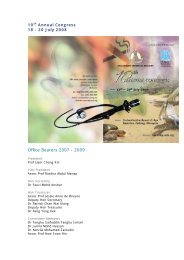download - Malaysian Thoracic Society
download - Malaysian Thoracic Society
download - Malaysian Thoracic Society
You also want an ePaper? Increase the reach of your titles
YUMPU automatically turns print PDFs into web optimized ePapers that Google loves.
Annual Congress of <strong>Malaysian</strong> <strong>Thoracic</strong> <strong>Society</strong><br />
Symposium 3B<br />
Interventional Pulmonology<br />
“Blind” versus EBUS-guided TBNA<br />
How Soon Hin<br />
Malaysia<br />
Transbronchial needle aspiration (TBNA) of mediastinal lymph node using flexible bronchoscope was first<br />
described in 1983. It is particularly useful to establish histological diagnosis in patients with peripheral lung<br />
lesion associated with mediastinal lymphadenopathy and staging of lung cancer. Apart from sampling of<br />
mediastinal lymph node, TBNA is also useful in the diagnosis and/or drainage of mediastinal cyst or mediastinal<br />
abscesses. The yield of TBNA in diagnosing medistinal lymph node in malignant disease ranged from 45% to<br />
96%. Factors affecting yields are governed by operator experience, type of needle, technique, tomographic<br />
evaluation, tissue preparation, tissue interpretation, nodal site and size, and more importantly, the use of<br />
ultrasound guided TBNA. In general, it is a safe procedure – though bleeding, bacteraemia, pneumothorax<br />
and pneumomediastinum may occasionally complicate the procedure.<br />
Symposium 3B<br />
Interventional Pulmonology<br />
Pleuroscopy: Revolutionising Management of Pleural Diseases<br />
Fauzi M Anshar<br />
Malaysia<br />
Pleuroscopy or medical thoracoscopy using purposely designed semi-rigid pleuroscope started in Malaysia in<br />
2004 in UKM Medical Centre. Prior to that, experienced physicians used to insert a bronchoscope into pleural<br />
cavity via a chest tube. Since 2004, the practice had become more widespread as more centres acquire the<br />
scope and more chest physicians become trained in its use. The main indications for pleuroscopy in Malaysia<br />
are diagnosing unexplained exudative pleural effusion and therapeutic manoeuvres such as talc pleurosdesis<br />
using talc poudrage which has a better success rate than using bedside talc slurry.<br />
Pleuroscopy requires relatively simple equipments and staffing level compared to that which are required<br />
for VATS. It can be done in an endoscopy suite with the patient under conscious sedation and has a high<br />
degree of patient safety and tolerability. The procedure is not difficult to master. In cases of undiagnosed<br />
pleural effusion, pleuroscopy allows complete drainage of pleural fluid, examination of pleura to allow a<br />
quick visual diagnosis and good sampling of pleural lesions under direct vision. Physicians can have a higher<br />
degree of certainty in calling the diagnosis and starting treatment especially in cases of TB pleuritis. Complete<br />
evacuation of infected pleural fluid allows the lung to expand and reduces risk of trapped lung. Thoracoscopy<br />
allows non-surgeon to intervene therapeutically by breaking down loculations and evacuating the fluid in<br />
early empyema and complicated parapneumonic effusion.<br />
In the future, pleuroscopy may replace the initial thoracocentesis and closed needle biopsy in cases of<br />
undiagnosed pleural effusion.<br />
29








